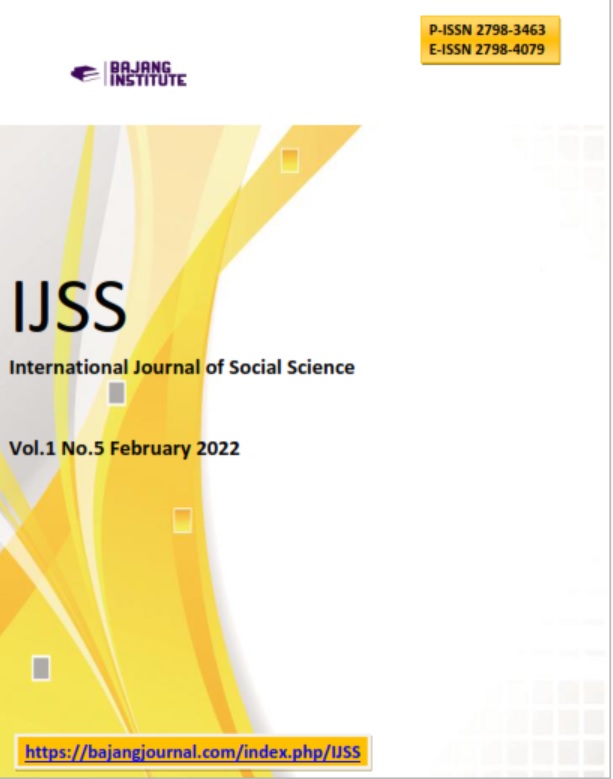DESIGNING SYLLABUS OF ENGLISH FOR TOURISM (EFT) FOR THE ELEVENTH GRADE STUDENTS OF SMK NEGERI 1 PRAYA IN THE ACADEMIC YEAR OF 2020/2021
DOI:
https://doi.org/10.53625/ijss.v1i5.1305Keywords:
Syllabus, English for Tourism, Needs Analysis.Abstract
The study aims at designing a syllabus of English for Tourism based on the level and the needs of the eleventh grade students at SMKN 1 Praya. The syllabus was designed based syllabus in the Curriculum 2013 where it focused on scientific approach. To design satisfactory syllabus, the researcher did Research and Development (R&D) study by adopting five steps; (1) doing needs analysis (2) drafting syllabus (3) implementing the product, (4) revising the syllabus and (5) designing the final product. In term of research method, the researcher employed qualitative method in gathering the data. Four data collection instruments, a questionnaire, interview, study documentary and observation, were used to know the students’ needs in the syllabus of English for tourism. The result of research was indicated that the most of respondents needed speaking skill in EFT course. Considering the findings, language functions and active learning were developed in the syllabus. There were two topics were developed namely topic of tourism object and local object. After drafting the syllabus, the researcher implemented the product at the restricted class and the whole class in five meetings. At the end of the implantation a feedback was administered, the result of which indicated that, the informants had positive opinion about the teaching and learning process by using the syllabus. To know the effectiveness of the syllabus, tests were given to students. From the results, they had significant progress from the first to the third test so that the syllabus was applicable to teach Mulok of English for Tourism for SMKN 1 Praya students.
References
Basturkmen, Helen. 2010. Developing Course in English for Specific Purposes. New Zealand: University of Auckland.
Bowen, J. Donald., and Madsen, Harold., and Hilferty, Ann. 1985. TESOL: Techniques and Procedures. Cambridge: Newbury House Publisher.
Gall. Meredith D. & Gall. Joyce P. 2003. Educational Research. New Jersey: Pearson Education, inc.
Harmer, Jeremy. 2007. The practice of English Language Teaching fourth Edition. England:Pearson Education.
Krahnke, Karl J. 1987. Approaches to Syllabus Design for Foreign Language Teaching. New Jersey: Prentice-Hall.
Nation, I.S.P. & Macalister, John. 2010. Language Curriculum Design. New York: Routledge.
Nunan, D. 1988. Syllabus Design. Oxford: Oxford University Press.
Parkes, Jay., and Harris, Mary. 2002. The Purpose of Syllabus vol. 50/no. 2. University of New Mexico. EBSCO Publishing.
Richard, Jack C. 1990. The Language Teaching Matrix. Cambridge: Cambridge University Press.
Richards, Jack C., and Lockhart, Charles. 2001. Curriculum Development in Language Teaching. Cambridge: Cambridge University Press.
Richards, Jack C., and Lockhart, Charles. 2013. Curriculum Approaches in Language Teaching : Forward, Central, and Backwash Design. Australia: University of Sydney.
Simion, Mindora Otilia. 2012. The Importance of Teaching English in The Field of Tourism in Universities: Economy Series, Issue 2/2012. Romania: University of Târgu-Jiu.
Stein, Miriam. 1999. Developing Oral Proficiency in the Immersion Classroom. ACIE Newsletter . Volume 2 Number 3 May 1999.
Sukmadinata, Nana Syaodih. 2012. Metode Penelitian Pendidikan. Jakarta: Remaja Rosdakarya.
Tomlinson, Brian. 1998. Materials Development in Language Teaching. Cambridge: Cambridge University Press.
Website Resmi Pemprov. NTB. 2013. Lombok Destinasi Terfavorit Kelima Nomor Tiga untk Wisata MICE.
Website Resmi Pemprov. NTB. (2013). NTB Raih Penghargaan Pariwisata. http://www.ntbprov.go.id/baca.php?beri ta=1179. Accessed on January 23rd, 2014 at 11.21 pm.

















